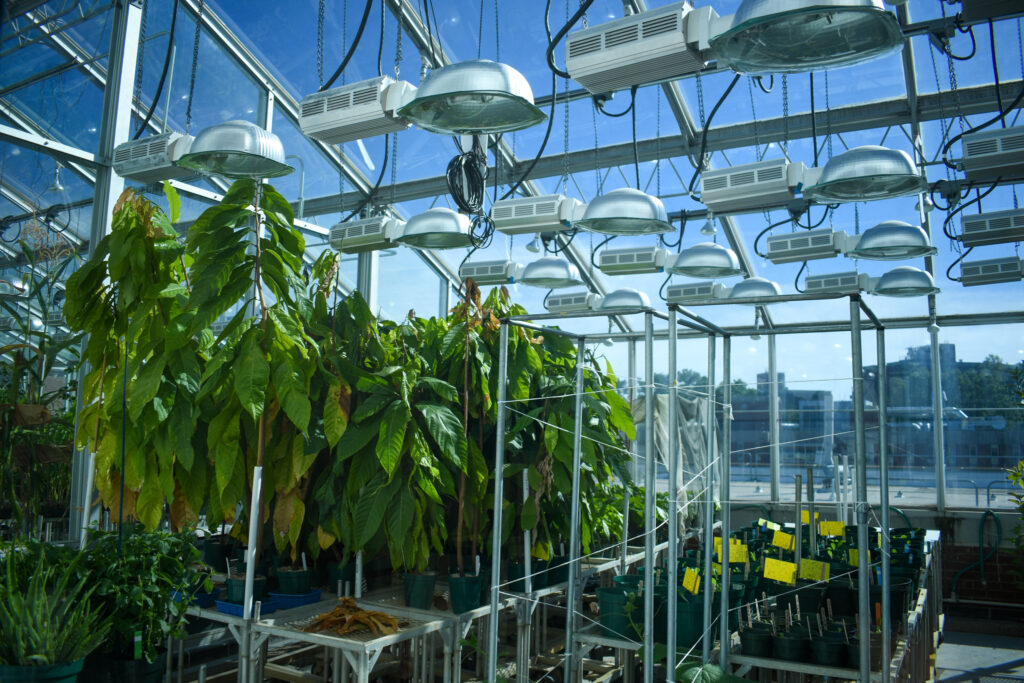
Photo by Sarah Cochran
By Max Nicely, Bran Poster, and Nada Elraddaf
Gardner Hall (Yes, it’s Gardner, not Gardener) is one of the buildings that hosts NC State’s department of Plant and Microbial Biology. Visitors to Gardner will see the usual campus accouterments, with a biological twist: infographics about invasive insects, cozy classrooms, and the occasional faculty office. However, the truly curious will find something altogether different. Go past the men’s bathroom and you’ll discover the entrance to a hidden research sanctuary: the Phytotron. What is this mysterious place, with a name that seems to have come from the Transformers movies? My fellow science storytellers and I decided to investigate with the help of the Phytotron’s director Dr. Carole Saravitz.
“Phyto is plant, tron is instrument” Dr. Saravitz said. The Phytotron is mainly growth chambers and greenhouses with controllable conditions for experimentation. It is technically not open to the public, but it does offer tours (as we were generously given). The Phytotron doesn’t belong to any one department and serves all of the College of Agriculture and Life Sciences. It is, however, primarily used by the Plant Sciences Department.
Speaking of plants, there is a species of plant called the cycad that particularly intrigues me. The cycad is one of the most ancient organisms on Earth, having existed virtually unchanged for more than 280 million years. The Phytotron, which was completed in 1968, is much like the cycad in that it remains a lively, relevant campus institution despite a lot of its equipment being unchanged since it was founded. While there have been past revitalizations, and there are ongoing revitalizations now, much remains dated. The Phytotron uses a 46-year old industrial air conditioner, a 54-year old elevator box, and in a throwback to the days of Edison, many of its growth chambers still use incandescent lightbulbs.
Notwithstanding these relics of the past, the Phytotron is unquestionably state-of-the-art: It’s no surprise that a facility specializing in plant research naturally lends itself to some pretty cutting edge studies. Dr. Saravitz says among her most memorable experiments ever to be conducted inside the Phytotron is one involving turf grass. One student wanted to see what effects painting grass has on the health of the organisms. The findings of his study showed that certain colors are naturally more harmful than others, implying that football stadiums may benefit from shifting their color pallets away from the darker, more harsh colors that are so popular.
However, the Phytotron is not limited to turfgrass management students (and fun fact; that’s a real program here at NC State): plant pathologists have also made use of the facility. During a tour, Dr. Saravitz brought us to the top floor of the building. We innocently stared through a glass window into a greenhouse growing several cocoa trees. The trees known to produce coco, a key ingredient in chocolate, looked incredibly ordinary when we didn’t know that they were the subjects of an experiment involving a pathogen which, should it be released into the wild, could potentially decimate North Carolina’s tomato plants. Once we were informed of as much, suddenly the cocoa trees both seemed more interesting and more ominous. According to Dr. Saravitz, the disease in question is “a tropical disease so it probably wouldn’t overwinter, but nobody wants to check.” And so, plant pathologists resort to using the facilities on the top floor of the Phytotron building.
As we gazed at the cocoa trees, we stood just outside an area which houses one of the most restricted places of the whole NC State campus: the biosafety level three lab. “We just don’t let people go in there. You have to go through training and you have to be fingerprinted and go through the USDA and go for a background check,” Dr. Saravitz said. The level three lab is apparently so secure that not even the technicians who implemented the keycard readers used to get into the lab itself are allowed inside it. All this is for good reason too: the lab conducts studies of pathogens which are oftentimes non-native to North Carolina. Should a pathogen escape, it could spell catastrophe for state agriculture, just think about that cocoa disease and our good friend, Bob The Tomato. When research concludes inside the level three lab, all biological materials used in the study exit the facility through an autoclave: a device otherwise known as a steam sterilizer. This practice ensures that nothing living can escape the lab: save for the scientists working inside the lab that is – they usually like to exit alive.
Similar to the autoclave, outside the building there’s another machine resembling a metal electrical box. Oftentimes, it’s seen radiating smoke as though it’s about to combust. Whenever the fire alarm goes off, the staff of the facility always have to remind everyone that the machine in question is in fact meant to be smoking: we know this with certainty because during our tour the fire alarm actually went off. We call that good journalism. But this raises the question, why is the machine smoking? Well, it’s effectively a sauna-esque death machine for transgenic plants. Transgenic plants have genomes which are not entirely their own. Scientists and researchers at the Phytotron use something called a “gene gun” (yes it really does look like a laser gun from Star Trek) to integrate DNA from other species directly into the cells of plants. This creates transgenic plants, organisms which often exhibit entirely noval properties. Many people know these plants under a different monocor: GMO’s. Although there is some debate about the ethics and nutrition surrounding genetically modified organisms, they’re not without their virtues. “I know a lot of people are anti-GMO, but sometimes then you can use less pesticides or you can make a crop, especially something grown in a third world country, more nutritious. So you can add a vitamin to something like rice,” Dr. Saravitz said. Whatever your opinion is on GMOs, you can rest assured that when a study involving transgenic plants concludes the transgenic plants go out of this world like a Norwegian on christmas: steaming to death.
At the time of its conception, our Phytotron was one of only six other phytotrons across the world. Since then, the research done at this historic facility has found ways to produce artemisia plants with higher levels of a compound that is used to treat malaria, is studying how salmonella contaminates fresh fruits and vegetables, and is finding ways to clean soil contaminated with E. coli or other pathogens. Developing new plant varieties and finding ways to combat diseases isn’t reserved just for research specialists or experts however. All departments and students, including undergraduate students, can submit a proposal to use the facility. For anyone interested in researching agricultural issues in the southeast region, or any plant science related question or experiment, the Phytotron is the place to go for any of your controlled-experiment needs.
If you are interested in contributing to the Phytotron in another way besides research, consider making a donation to the Phytotron Enhancement Fund or the Giles Phytotron Endowment, which was established in memory of the first director of the Phytotron, Dr. Jack Downs. Every donation helps fund the high quality research conducted here that gives back to our community. From international issues, to local farmers, everyone stands to benefit from the work done at the Phytotron.
To apply to use the Phytotron, make a donation, or learn more about the extent of the facilities and what research is done at this campus gem, visit phytotron.ncsu.edu.

